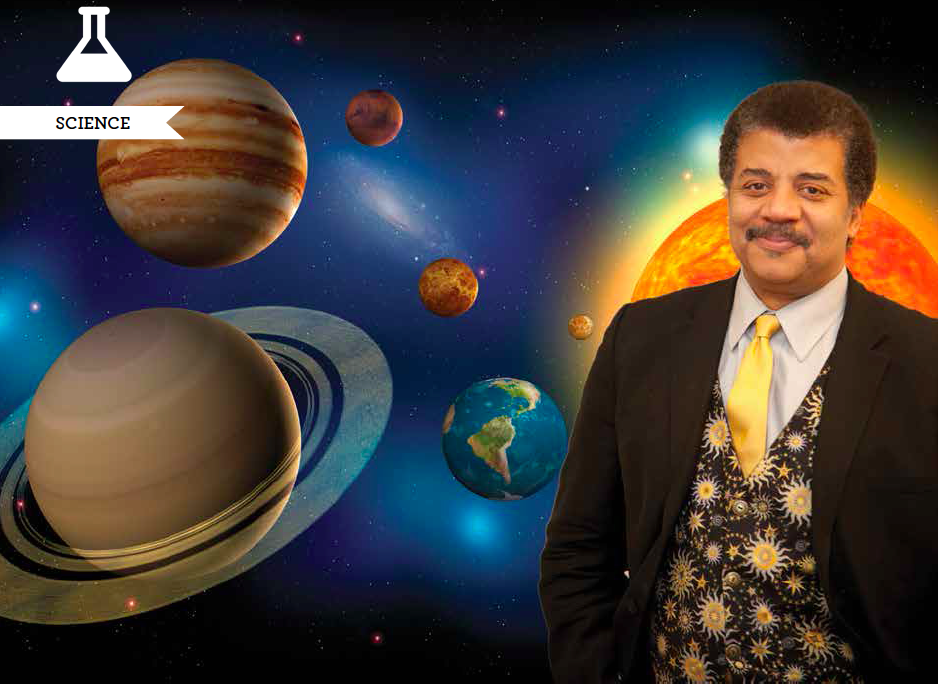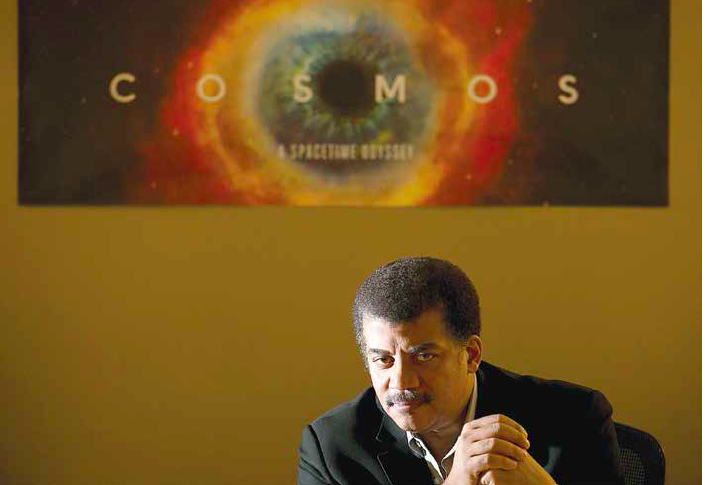By now you’ve probably seen an episode or two of Cosmos: A Space-Time Odyssey. An orchestral tune plays behind stunning galactic images. Astrophysicist Neil deGrasse Tyson zips across the Universe, defying the laws of space-time, while crossing into the unknown in his “Ship of the Imagination.” Tyson coolly puts on black sunglasses right before the Big Bang explodes the Universe into being. This is a fan-boy’s fantasy for sure. In last month’s issue we covered the difficulty of filling Carl Sagan’s shoes, Dr. Tyson’s long love affair with the stars, and his devotion to improving science literacy in the public. In this issue we’ll delve further into Cosmos, which premiered Sunday, March 9th on Fox.
While Tyson plays an ultra-cool guide to the Universe in Cosmos, his real demeanor and style is less Matrix, and much more quirky scientist—with vests and ties emblazoned with burning suns, and a funky office perched above Hayden Planetarium.
In the past Tyson made good contributions towards understanding cosmic phenomena like galactic bulges and stellar formation, though these days he isn’t much of a hardcore research scientist. Neil deGrasse Tyson is something of an ambassador to the Universe. He represents the Universe, like a diplomat to the State, in such a way as to make it clear and engaging to a large number of people. Tyson represents the Universe, by bringing science into everyday life.
Neil is fun to listen to—with a deep, mellow voice, which sometimes turns into a growl when he gets worked up about something. When he gets heated it’s either in excitement over a really interesting scientific fact, or else some indignation at the ignorance that humanity is capable of.
When Tyson talks about the Universe, he has a way of really getting you to listen, by making it clear that it’s important to have this knowledge. Learning about the Universe, and about how life on Earth came to be through stellar events and evolution, can be a kind of self-knowledge, or realization of our own existence in relation to the Universe.
Of course, one of greatest proponents of self-knowledge through study of the Universe was Carl Sagan. A few times during our interview, Tyson spoke warmly about Sagan, the highly influential astronomer and host of the original Cosmos series. Sagan had fist reached out to Tyson, when the young Tyson was deciding where to get his undergraduate degree. While Tyson went on his own path, the fact the Sagan went so far to reach out to him made a lasting impact on his own life and teaching style. When Cosmos first aired in 1980, Tyson was already in grad school and deep into his research. While it didn’t necessarily teach him anything new scientifically speaking, Tyson says that the original series taught him something else.
“The effect that it had on me at the time, was to see and notice that it was possible to bring the Universe to the public in such a way that people would embrace learning, and embrace the power of knowledge of our place in the Universe,” Tyson said. “To learn what our place is in the Universe is deep—it’s emotionally deep, it’s philosophically deep, it’s even spiritually deep—and it’s these kinds of messages, that were put forth in the original Cosmos, that it my judgment made it something that people never forgot.”
What made the original series so accessible was both Sagan’s down-to-earth, inspired way of speaking about the Universe, as well its enticing aesthetic quality. The latest installment of Cosmos has that same feeling; lush and mysterious images of supernovas and black holes draw the eye in, while Tyson explains these majesties in a way that engages nearly all age groups.
A major reason why the new Cosmos is so easily consumable is that serious creative talent backs it. Executive Producer/Writer Ann Druyan served as Creative Director of NASA’s Voyager Interstellar Message Project—establishing a series of messages known as “The Golden Records,” placed aboard Voyager 1 and 2 interstellar spacecraft, which are now leaving the solar system. Thanks to this project, extraterrestrial civilizations may someday enjoy the Beatles as we much as we have. Druyan also co-wrote six New York Times best-sellers with her late husband, Carl Sagan.
Seth MacFarlane, the comedic mastermind behind Family Guy, is Executive Producer. He has said that he wanted to put some of his “disposable income” to good use. Director/Director of Photography is cinematographer Bill Pope, who worked on The Matrix trilogy, along with Men in Black 3, Spiderman 2, and Spiderman 3.
“These are people who think long and hard about interesting things to do with the camera lens to capture and convey an idea, or an emotion, or a scene…and so here we are filming the Universe (me dipping down into the sun, slipping through a black hole, watching galaxies collide) and he [Pope] has ideas about how to portray that will affect you not only intellectually, as any good documentary would, but also affect you emotionally, psychologically—so the power of Cosmos in this latest version to influence a viewer is magnified because of these technologies made available to us,” Tyson said.
The potential for Cosmos to introduce entirely new groups of people to science is great. Besides playing on Fox, the show also plays on the National Geographic Channel. Cosmos airs on 200 outlets internationally, in 171 countries, and in 45 languages. This enormous coverage will certainly help in some way to realize one of Tyson’s longstanding goals: to bring science to the masses, as an inescapable part of ordinary life.
“When you see science as an everyday thing…science is life, science is policies that you’re voting on, science is your health, science is your future, science is that asteroid that might be coming to hit earth, science is explosions on the sun that affect our communication satellites, science is transportation, science is energy…science is the warming of our climate—you can’t say, ‘I don’t care about science,’ and be a member of modern society,” Tyson said.
“I’ve learned as an educator that people like becoming enlightened: they like having a new perspective on themselves, and on life, and on the world, that they didn’t have before, that can be empowering,” Tyson said. “What I like to think is that Cosmos will change how we think about the role of science, as a fundamental part of modern society. When you do that, it would be unforgivable to shrink a space program.”
As for the reasons behind the new Cosmos, Druyan has said that it’s about “making the case for science,” in a societal climate fraught with scientific misunderstanding and ignorance. “I think Cosmos will in a big way help to mainstream science, so that everybody will care about it, and you cannot allocate it to the concern of others,” Tyson said.
One part of society’s disconnect with science, as Druyan has addressed in interviews, is that science is often taught in such a grueling way, as to all but extinguish the creative urge essential to meaningful scientific discovery and innovation. Cosmos helps solve this problem by making science sexy.
The simple truth is that the Universe is fascinating, awe-inspiring, and a blast to look at. Nebulae, or interstellar clouds of dust, hydrogen, helium, and other gases bloom like magnificent flowers in the cold of space. These are often nurseries for space-stuff— bearing out stars and planets. The rings of Saturn, composed of water ice and trace rocky material, like some impossible hoola hoop of the heavens. This type of natural beauty shouldn’t be hard to sell; it is sexy, and it reminds us that we are all lucky enough to be a part of the greatest show there is.
However, despite the allure of cosmic activity, the mechanics behind it can get pretty complicated. This is why, I for one, am happy to have a guide as informed and down-to-earth (excuse the pun) as Tyson—to help us explore the great expanses of space, and realize how science enriches our understanding of the Universe.
“If you think of Cosmos as a way to learn about why science matters, then I’m your next host in that journey,” said Tyson.


